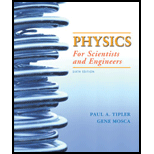
Concept explainers
(a)
The time period of oscillating system.
(a)
Explanation of Solution
Introduction:
Time period of oscillating system is the time required by system to complete one oscillation.
The free body diagram of system is drawn below.

Here,
Write the expression for time period of the pendulum.
Here,
Write the expression for resultant force in horizontal direction.
Substitute
Here,
Write the expression for resultant force in horizontal direction.
Substitute
Here,
Rearrange the above expression in term of
Substitute
Substitute
Rearrange the above expression in term of
Compare the above expression with the equation of differential equation of S.H.M.
The value of angular frequency is
Substitute
Conclusion:
Thus, the time period of oscillating system is
(b)
The value of force constant.
(b)
Explanation of Solution
Given:
The mass of bob is
The first time period of the pendulum is
The second time period of the pendulum is
Formula:
The free body diagram of system is drawn below.

Here,
Write the expression for time period of the pendulum.
Here,
Write the expression for resultant force in horizontal direction.
Substitute
Here,
Write the expression for resultant force in horizontal direction.
Substitute
Here,
Rearrange the above expression in term of
Substitute
Substitute
Rearrange the above expression in term of
Compare the above expression with the equation of differential equation of S.H.M.
The value of angular frequency is
Substitute
Calculation:
For
Substitute
For
Substitute
Conclusion:
Thus, the value of force constant is
Want to see more full solutions like this?
Chapter 14 Solutions
Physics For Scientists And Engineers
- If a car has a suspension system with a force constant of 5.00104 N/m , how much energy must the car’s shocks remove to dampen an oscillation starting with a maximum displacement of 0.0750 m?arrow_forwardCan this analogy of SHM to circular motion be carried out with an object oscillating on a spring vertically hung from the ceiling? Why or why not? If given the choice, would you prefer to use a sine function or a cosine function to model the motion?arrow_forwardGive an example of a simple harmonic oscillator, specifically noting how its frequency is independent of amplitude.arrow_forward
- Check Your Understanding Identify one way you could decrease the maximum velocity of a simple harmonic oscillator.arrow_forwardSome people think a pendulum with a period of 1.00 s can be driven with “mental energy” or psycho kinetically, because its period is the same as an average heartbeat. True or not, what is the length of such a pendulum?arrow_forwardRefer to the problem of the two coupled oscillators discussed in Section 12.2. Show that the total energy of the system is constant. (Calculate the kinetic energy of each of the particles and the potential energy stored in each of the three springs, and sum the results.) Notice that the kinetic and potential energy terms that have 12 as a coefficient depend on C1 and 2 but not on C2 or 2. Why is such a result to be expected?arrow_forward
- A diver on a diving board is undergoing SHM. Her mass is 55.0 kg and the period of her motion is 0.800 s. The next diver is a male whose period of simple harmonic oscillation is 1.05 s. What is his mass if the mass of the board is negligible?arrow_forwardFind the frequency of a tuning fork that takes 2.50103 s to complete one oscillation.arrow_forwardAn automobile with a mass of 1000 kg, including passengers, settles 1.0 cm closer to the road for every additional 100 kg of passengers. It is driven with a constant horizontal component of speed 20 km/h over a washboard road with sinusoidal bumps. The amplitude and wavelength of the sine curve are 5.0 cm and 20 cm, respectively. The distance between the front and back wheels is 2.4 m. Find the amplitude of oscillation of the automobile, assuming it moves vertically as an undamped driven harmonic oscillator. Neglect the mass of the wheels and springs and assume that the wheels are always in contact with the road.arrow_forward
- Suppose a diving board with no one on it bounces up and down in a SHM with a frequency of 4.00 Hz. The board has an effective mass of 10.0 kg. What is the frequency of the SHM of a 75.0-kg diver on the board?arrow_forwardDetermine the period of oscillation of a simple pendulum of length L suspended from the ceiling of a car that rolls down an inclined plane of angle (Fig. P16.73). Dissipative forces between the car and the plane are negligible.arrow_forwardThe temperature of the atmosphere oscillates from a maximum near noontime and a minimum near sunrise. Would you consider the atmosphere to be in stable or unstable equilibrium?arrow_forward
 Classical Dynamics of Particles and SystemsPhysicsISBN:9780534408961Author:Stephen T. Thornton, Jerry B. MarionPublisher:Cengage Learning
Classical Dynamics of Particles and SystemsPhysicsISBN:9780534408961Author:Stephen T. Thornton, Jerry B. MarionPublisher:Cengage Learning University Physics Volume 1PhysicsISBN:9781938168277Author:William Moebs, Samuel J. Ling, Jeff SannyPublisher:OpenStax - Rice University
University Physics Volume 1PhysicsISBN:9781938168277Author:William Moebs, Samuel J. Ling, Jeff SannyPublisher:OpenStax - Rice University Physics for Scientists and Engineers: Foundations...PhysicsISBN:9781133939146Author:Katz, Debora M.Publisher:Cengage Learning
Physics for Scientists and Engineers: Foundations...PhysicsISBN:9781133939146Author:Katz, Debora M.Publisher:Cengage Learning Principles of Physics: A Calculus-Based TextPhysicsISBN:9781133104261Author:Raymond A. Serway, John W. JewettPublisher:Cengage Learning
Principles of Physics: A Calculus-Based TextPhysicsISBN:9781133104261Author:Raymond A. Serway, John W. JewettPublisher:Cengage Learning Physics for Scientists and Engineers with Modern ...PhysicsISBN:9781337553292Author:Raymond A. Serway, John W. JewettPublisher:Cengage Learning
Physics for Scientists and Engineers with Modern ...PhysicsISBN:9781337553292Author:Raymond A. Serway, John W. JewettPublisher:Cengage Learning Physics for Scientists and EngineersPhysicsISBN:9781337553278Author:Raymond A. Serway, John W. JewettPublisher:Cengage Learning
Physics for Scientists and EngineersPhysicsISBN:9781337553278Author:Raymond A. Serway, John W. JewettPublisher:Cengage Learning





